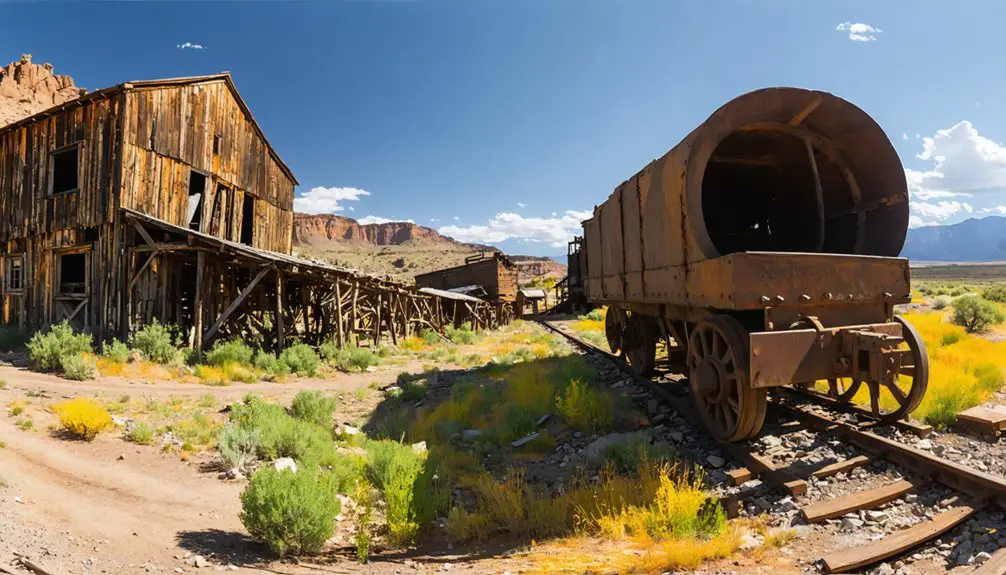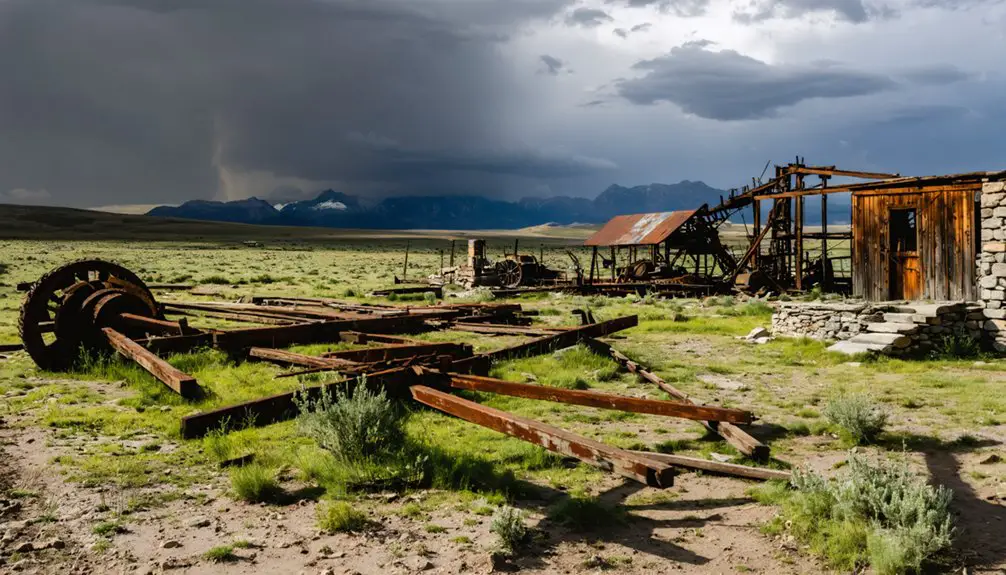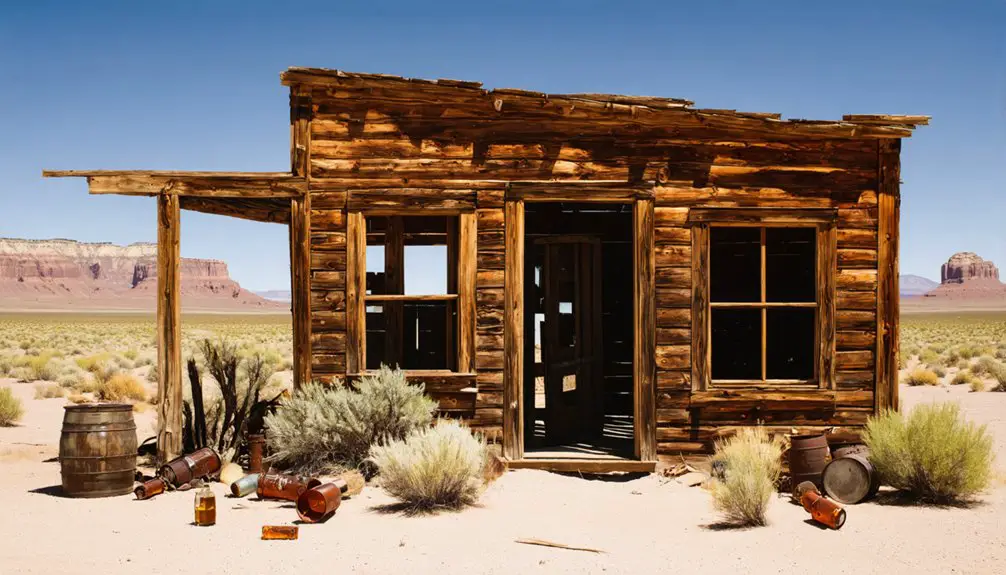You’ll find Grass Creek’s remnants tucked away in Grass Valley Canyon, 8.5 miles from Coalville, Utah. This coal mining company town flourished from 1859 through the early 1900s, featuring 40 company-built houses, a schoolhouse, and company store. At its peak in 1910, 190 residents, mostly immigrants from Scotland, England, and Wales, called it home. While only concrete slabs remain today, this ghost town’s rich mining legacy tells a fascinating story of boom-and-bust Utah.
Key Takeaways
- Grass Creek was a coal mining company town established by the Grass Creek Fuel Company in Grass Valley Canyon, Utah.
- The town peaked around 1910 with 190 residents, mostly skilled immigrant miners from Scotland, England, and Wales.
- The community featured 40 company-built houses, a schoolhouse, company store, and boardinghouse during its prime.
- Mining operations declined due to unstable coal seams, persistent flooding problems, and competition from higher-quality coal sources.
- Today, the ghost town site is privately owned with only concrete slabs remaining from its mining operations.
The Discovery of Coal in Grass Valley Canyon
When prospectors discovered coal near the Weber River in 1859, it sparked a chain of events that would establish the town of Coalville and lead to further exploration in nearby Grass Valley Canyon.
The following year, Brigham Young commissioned a search party that yielded impressive results. During a hunting expedition, John Muir and Samuel Fletcher made a significant coal seam discovery, identifying a massive 10-foot deposit in the canyon. The coal deposits were particularly valuable due to their location in Grass Valley Canyon, just 8.5 miles from Coalville.
Brigham Young’s search party struck gold in coal when hunters discovered a remarkable 10-foot seam in the canyon.
The Church of Jesus Christ of Latter-day Saints quickly seized this opportunity by opening the Church Mine, with operations led by Daniel H. Wells, Bryant Stringham, and Stephen Taylor. Coal was initially transported by wagon to Echo and then transferred to rail for delivery to various destinations.
This initial development in Grass Valley would transform the remote canyon into a bustling mining district, setting the stage for decades of coal extraction.
Rise of a Company Town
After discovering substantial coal deposits in Grass Valley Canyon, the Grass Creek Fuel Company established a bustling company town that transformed the remote canyon into a thriving mining community.
You’d find about 40 company-built houses on the canyon’s north side, ranging from basic miners’ shacks to elaborate stone homes for the owners. The town’s business district sat primarily on the south side, featuring a dual-purpose schoolhouse, company store, and boardinghouse.
Under company ownership, the population reached 190 by 1910. The immigrant workforce, mainly from Scotland, England, and Wales, brought skilled mining expertise to the operation. To avoid confusion with other locations, the town was often referred to as Grass Creek, Utah in official documents.
Though Chinese laborers initially worked the mines, they were forced out by 1885. A railroad spur, added around 1880, connected the town to broader markets and spurred its growth.
Mining Operations and Challenges
Mining at Grass Creek proved challenging from the start, with the area’s soft clay geology and persistent water problems creating hazardous conditions for workers.
You’d find mines constantly battling geological instability, requiring extensive structural support systems just to keep tunnels from collapsing.
Water management became the operation’s biggest headache, as flooding regularly threatened both safety and productivity.
Relentless flooding posed a constant threat to miners, turning basic water management into a daily battle for survival and efficiency.
Steam-powered pumps worked around the clock to remove water from the tunnels, while Crawford fans maintained crucial air circulation.
Despite these efforts, you couldn’t escape the high operational costs.
The mines remained relatively small-scale, with operations like the Cullen Mine employing just 12 workers and producing 50 tons daily.
Even the larger operations struggled, with some mines extending 1,400-foot slopes into the challenging terrain.
Daily Life and Community Infrastructure
You’ll find the heart of Grass Creek’s social life centered in the multipurpose schoolhouse, which doubled as a church and community gathering space.
The town’s housing reflected clear socioeconomic divisions, from simple miners’ shacks to elaborate stone homes for mine owners, with about forty company-built houses added during an 1899 expansion.
The company store and general mercantile served as essential hubs for daily necessities, with the mercantile also housing the post office for the close-knit mining community.
School and Social Center
During its active years, Grass Creek’s single schoolhouse served as the heart of community life, functioning not only as an educational facility but also as a gathering place for Mormon Church meetings.
The multi-purpose structure provided basic educational methods for children of miners while fostering what little social cohesion existed in this transient mining town. Similar to Blue Creek’s two-room schoolhouse, the building served the educational needs of local families until its eventual closure. Community gatherings centered primarily around religious services and school functions, as the town lacked other dedicated social spaces.
- You’d find multiple grade levels sharing one classroom, typical of mining town education
- The building became especially crucial after 1904 when both school and post office were established
- Mormon religious services shared the space, making it the town’s primary meeting point
- Without social halls or clubs, this schoolhouse remained your only option for organized gatherings
Housing and Company Store
As Union Pacific Railroad expanded its coal operations in 1880, Grass Creek’s housing infrastructure took shape with roughly 40 company-owned residences for miners and their families.
These simple dwellings were strategically placed near the mines, prioritizing function over comfort. By 1899, Grass Creek Coal Company added three more houses and a boardinghouse to accommodate growing workforce needs. Similar to Utah’s Old Iron Town, this mining community’s prosperity was directly tied to natural resource extraction.
The housing conditions reflected the miners’ economic dependence on the company. You’d find yourself relying on the company store, which served as both general mercantile and post office.
Like most miners, you’d likely purchase goods on credit, with payments deducted from your wages. While the store provided essential supplies from food to mining equipment, this system reinforced the company’s control over daily life in this isolated community.
Peak Years and Economic Impact

During Grass Creek’s peak years from 1881 to 1910, you’d have witnessed daily coal production reaching up to 50 tons at the Cullen mine alone, while other operations like the Old Church mine contributed an additional 30 tons per day.
The town’s strategic railroad connections enabled efficient coal transport to Salt Lake City, establishing Grass Creek as a crucial energy supplier for Utah’s growing industries.
You’d have seen David Eccles’ Union Fuel Company transform the area’s mining landscape after 1907, when his enterprise consolidated over 1,000 acres of coal-rich land and implemented advanced ventilation and pumping systems.
Mining Production Heights
While coal mining in Grass Creek spanned several decades, the town’s peak production years occurred between 1881 and 1910, transforming the area into a bustling mining hub with 190 residents. The town eventually reached peak population of 200 during the height of mining operations.
You’d find advanced coal seam technology for the era, including steam-powered ventilation fans and pumps that helped maintain mining safety standards.
In 1907, David Eccles’ Union Fuel Company controlled over 1,000 acres of coal fields, streamlining operations across the region.
- The Cullen mine produced 50 tons daily by 1896
- Local mines employed dozens of workers, with Cullen alone supporting 12 miners
- A school and post office emerged by 1904, marking community growth
- Rail infrastructure connected Grass Creek’s coal to Salt Lake City markets
Railroad Transportation Hub
The 1896 completion of a narrow gauge railroad spur marked a turning point for Grass Creek’s mining operations, connecting the town directly to the Union Pacific Railroad‘s main line.
You’d no longer see the grueling fifty-mile wagon hauls to Salt Lake City that had hindered coal transport, especially during harsh winters.
Railroad efficiency peaked in the late 1890s through the early 1900s, transforming Grass Creek into a significant transportation hub.
The improved infrastructure sparked industrial growth as ancillary businesses sprouted up to serve train crews and maintenance needs.
Following the Union Pacific bankruptcy of 1893, the reorganization efforts strengthened the railroad’s presence in mining communities like Grass Creek.
You’ll find that this period brought unprecedented economic integration, with the railroad reducing transport costs and attracting workers to the area.
The rail connection positioned Grass Creek as an essential link in Utah’s expanding mining network, supporting Salt Lake City’s growing energy demands.
After the railroad’s abandonment in 1989, the local community rallied to transform the historic rail corridor into a recreational trail.
David Eccles’ Business Empire
As David Eccles built his fortune in Utah’s burgeoning economy, he transformed from a modest lumber merchant into the state’s first multimillionaire through strategic diversification and reinvestment. His business empire expanded rapidly across the Intermountain West, where his wealth accumulation reached between $5-6 million over 23 years. After selling his beet sugar factories to American Sugar Refining Company, he solidified his position as one of Utah’s most influential businessmen.
Starting as a youth selling resin sticks in Glasgow, his early experiences shaped his entrepreneurial drive. You’ll find his influence stretched across Utah’s industrial landscape, from lumber mills to sugar factories.
- Presided over 17 industrial corporations and 7 banks by 1912
- Built 700 miles of Western Pacific Railroad track through Utah Construction Company
- Provided interest-free loans to support local religious and community projects
- Established mills, stores, and lumber yards in towns like Ogden, Scofield, and Beaver Canyon
His business diversification strategy created jobs and boosted economic growth throughout the region, leaving a lasting legacy in Utah’s development.
Decline and Modern Remnants

Despite its promising start as a coal mining settlement, Grass Creek began a steady decline in the early 1900s due to mounting operational challenges.
What began as a hopeful coal mining venture in Grass Creek soon crumbled under the weight of operational difficulties.
You’ll find the town struggled with unstable coal seams embedded in soft clay, while persistent flooding made mining both dangerous and costly. Economic competition from safer, higher-quality coal sources elsewhere weakened Grass Creek’s position, leading to community decline after 1910.
When the Croydon cement plant closed in 1931, demand plummeted further. By 1932, Union Pacific abandoned the railroad spur, isolating the town completely.
Today, you can’t visit the site – it’s all privately owned. The buildings and machinery were mostly gone by 1887, though some concrete slabs remain from later operations that continued sporadically into the early 1940s.
Frequently Asked Questions
Are There Any Reported Ghost Stories or Paranormal Activities in Grass Creek?
Cold as a grave, you won’t find documented ghost sightings or paranormal investigations here. The area’s been private property since 1940, and there aren’t any verified supernatural reports in historical records.
What Happened to the Residents After the Town Was Abandoned?
You’ll find former residents scattered widely, with many relocating to Coalville and Park City for mining work, while others moved to Salt Lake City or left Utah entirely seeking new opportunities.
Can Visitors Access Any Original Artifacts From the Grass Creek Mines?
Like ghosts of mining history, original artifacts remain out of reach. You can’t access any authentic Grass Creek mine relics since they’re on private land or were removed during preservation efforts.
Were There Any Major Mining Accidents or Disasters in Grass Creek?
While mining safety was poor, historical accidents were limited to six documented individual fatalities between 1902-1925. You won’t find evidence of major disasters like Utah’s Castle Gate explosion here.
What Native American Tribes Originally Inhabited the Grass Creek Area?
You’ll find that the Goshute, a subgroup of Western Shoshone, primarily lived in Grass Creek’s area, along with some Ute Tribe presence. Both adapted expertly to the region’s challenging desert environment.
References
- https://utahrails.net/utahcoal/grass-creek.php
- https://en.wikipedia.org/wiki/Grass_Creek
- https://utahrails.net/pdf/Grass-Creek-Mine_Utah-Abandoned-Mine-Reclamation-Program_1986.pdf
- https://kids.kiddle.co/Grass_Creek
- https://onlineutah.com/grasscreek_history.shtml
- https://www.uen.org/utah_history_encyclopedia/c/COALVILLE.shtml
- https://www.boxeldercountyut.gov/523/Blue-Creek-History
- https://utahrails.net/pdf/Summit-County-railroads-and-coal-mines_DUP-Echoes-of-Yesterday_1947.pdf
- https://www.youtube.com/watch?v=AoiIha-3iNo
- https://www.summitcountyutah.gov/199/Discovery-of-Coal



